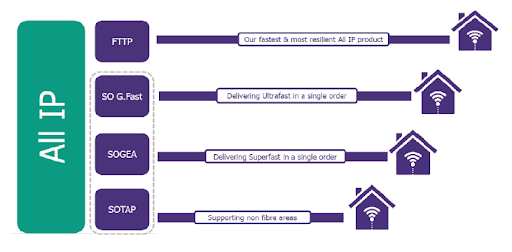Most people in the telecommunications sector will be aware that the current Public Switched Telephone Network (PSTN) is being switched off in stages – and entirely by 2027. This has been driven by the traditional copper line telephone network coming to its end of life and being replaced by fibre optic digital networks. Not all areas will have full fibre connectivity straight away. Some areas will operate with a mixture of full fibre and copper networks during the transition.
Openreach has already announced ‘stop sell’ at over 2,900 locations, and this will be across the whole UK from September 2023 meaning anyone across the UK signing up to a new contract (whether switching provider, upgrading or moving) will have no choice but to take up a new fibre connection where one is available.
With growing demand for data-intensive internet services, it is widely accepted that all operators will follow BT’s lead with a migration to all-IP. BT’s target is 2027, leaving a lot to be done in the next few years!
The products available from Openreach are summarised below with the key thing to note being the end of WLR and ISDN services.

CCUK members provide VoIP and other communication services that are designed for use over broadband (IP networks) – once seen as niche, these services are now mainstream. This transition to all-IP is a great opportunity for members to expand the reach of their services whilst providing greater choice for consumers.
However, there are also some challenges to be overcome, and CCUK is currently focussed on the following:
The PSTN switch-off will have a wide-ranging impact on a number of services previously developed to work on the analogue copper lines. For example:
It is imperative that all sections of society are aware of the change, how it may impact them, and how this is not an up-sell.
Price controls in areas of limited or no competition have been put in place by Ofcom. However, Openreach will not offer any wholesale voice solution, meaning that hundreds of existing WLR resellers wishing to continue to provide a ‘lines and calls’ service will need to seek a reseller deal adding an extra relationship to manage as well as resulting in some additional consolidation of the voice market.
In addition, in areas where there is no fibre available yet and WLR has been withdrawn, there will be a drastically reduced pool of providers able to offer service, since SOTAP (Single Order Transitional Access Product) will only be available to a handful of major carriers who have equipment located within Openreach exchanges.
It has been obvious for some time now that the planning and focus for migration has leaned heavily towards the residential market. The above concerns aside, we anticipate a standard residential consumer will be well-served with sufficient broadband bandwidth and calling capability.
However, this is not proving to be the case with business users. Where good fibre connectivity is reported to be available for installation, we are getting reports of long installation delays.
There are particular concerns in any areas where fibre is not available, and it is our view that SOTAP is not fit for purpose as a replacement for ISDN services and will not serve business premises well at all.
Whilst CCUK will keep lobbying Ofcom, DSIT and a number of other related parties to work on these challenges, it’s important that our members each take control of their own customer base as early as possible. Stop-sell dates have already been released for many BT exchanges.
The following steps will help us all get this migration delivered as smoothly as possible:
Make sure each of your customers understands what is happening and why. You can direct them to the companion document to this for consumers on the PSTN section of the CCUK website, where you will also find links to other official useful guidance.
Your customers are likely to be relying on you to tell them what services they have that might fail, so it’s important you get to know what they use (e.g. fax machine, alarm systems etc) and work through the options for migration. Pay special attention to issues created in the event of a power cut, particularly if the customer has an obligation to allow emergency calls. If big changes are needed, they will need plenty of time to budget and plan.
Be clear on what services are available to you and how you will deliver them to your customer. Remember that if they want to make any changes to their existing service and are in a fully-served fibre area, they will probably have no alternative to a migration at that point, so it’s better to be ready.
With Openreach no longer offering voice calls as part of their solution, there is a large market of potential new consumers for OTT voice services. Many existing providers will offer a complete data and voice package making it simple for their customers to consume the service, but there will also be the potential to win new business from those wishing to separate their voice and broadband providers or benefit from a more flexible and innovative voice solution. It is important to position yourself in the market as soon as possible.
Comms Council UK are a UK, membership-led organisation that represents companies who provide or resell business and residential customers voice services over data networks (VoIP) as well as other “over the top” applications including instant messaging and video.